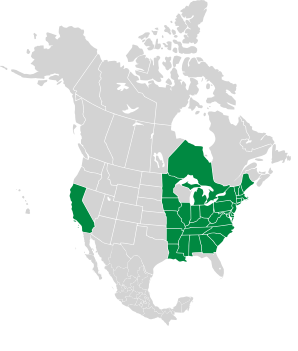Ephemerum congestum Moench
Tradescantia brevicaulis Raf.
Tradescantia congesta (Moench) D. Don
Tradescantia rupestris Raf.
Tradescantia speciosa Salisb.
Tradescantia virginiana L. var. alba Hook. ex Raf.
Tradescantia virginiana L. var. barbata Raf.

|
Tradescantia virginiana L. Virginia spiderwort
Spiderworts are named for the resemblance of their leaves to a squatting spider. The genus Tradescantia is named for John Tradescant, a gardener for Charles I of England. There are about 71 species. Identification: Virginia spiderworts are 8-36″ (20-91 cm) high. Leaves are long and narrow, dark or olive green, with parallel veins, like wide grass blades. They are up to 1′ (30 cm) × 1″ (2.5 cm). Flowers are blue or purple, ¾-2″ (1.9-5 cm) in diameter, with three petals and six stamens, each with yellow anthers. There are two bracts beneath each flower. Each flower lasts only a single day. Here are a few species: |
6/5/2013 · Nashua River Rail Trail, Groton Center, Groton, Massachusetts · ≈ 12 × 8″ (31 × 21 cm) 6/22/2017 · Garden in the Woods, Framingham, Massachusetts · ≈ 8 × 5″ (20 × 13 cm) |
||||||||||||||||||||||||||||
|
| |||||||||||||||||||||||||||||
Tradescantia occidentalis |
Tradescantia pinetorum |
You are here Tradescantia virginiana |
|||||||||||||||||||||||||||
|---|---|---|---|---|---|---|---|---|---|---|---|---|---|---|---|---|---|---|---|---|---|---|---|---|---|---|---|---|---|
| Common Name |  |
 |
 |
||||||||||||||||||||||||||
| Plant | Up to 2′ (60 cm) tall. Has smooth stems with several joints | 8-20″ (20-50 cm) high | 8-36″ (20-91 cm) high | ||||||||||||||||||||||||||
| Flowers | Bright blue to rose or purple, about ¾″ (1.9 cm) in diameter, with three petals and six stamens with yellow anthers. | Blue to purple flowers about ¾″ (1.9 cm) in diameter, with six stamens with yellow anthers. Small hairs are on various parts of the flower. All petals are equal in size. | Blue or purple, ¾-2″ (1.9-5 cm) in diameter, with three petals and six stamens, each with yellow anthers. There are two bracts beneath each flower | ||||||||||||||||||||||||||
| Leaves | Long and narrow, with a whitish covering | 2-5″ (5-12 cm) long, sometimes much longer, and narrow, like blades of grass | Long and narrow, dark or olive green, with parallel veins, like wide grass blades. Up to 1′ (30 cm) × 1″ (2.5 cm) | ||||||||||||||||||||||||||
| Range/ Zones |
|
|
|
||||||||||||||||||||||||||
| Habitats | Plains, prairies, disturbed sites | Open brush, woods and wooded slopes, especially pine woods | Prairies, thickets, woodland edges, power line clearences | ||||||||||||||||||||||||||
| Type | Wild | Wild | Wild | ||||||||||||||||||||||||||
| Occurrence | Common | Common | Common | ||||||||||||||||||||||||||
Edibility: Leaves and stems are edible, either fresh or cooked.
Online References:
The Lady Bird Johnson Wildflower Center
Plants for a Future, a resource and information centre for edible and otherwise useful plants
The University of Wisconsin's Robert W. Freckmann Herbarium
The USDA Plants Database (PDF)
References:
6/1/2010 · Nashua River Rail Trail, Groton Center, Groton, Massachusetts · ≈ 17 × 12″ (44 × 29 cm) ![]() ID is uncertain
ID is uncertain 
6/1/2010 · Nashua River Rail Trail, Groton Center, Groton, Massachusetts · ≈ 6 × 4″ (15 × 10 cm) ![]() ID is uncertain
ID is uncertain 
7/1/2023 · Pocahontas State Park, Chesterfield, Virginia 
5/22/2010 · Garden in the Woods, Framingham, Massachusetts · ≈ 15 × 10″ (39 × 26 cm) ![]() ID is uncertain
ID is uncertain 
6/5/2013 · Nashua River Rail Trail, Groton Center, Groton, Massachusetts · ≈ 6 × 3½″ (14 × 9.6 cm) 
7/3/2023 · Gettysburg National Military Park, Gettysburg, Pennsylvania 
Ephemerum congestum Moench
Tradescantia brevicaulis Raf.
Tradescantia congesta (Moench) D. Don
Tradescantia rupestris Raf.
Tradescantia speciosa Salisb.
Tradescantia virginiana L. var. alba Hook. ex Raf.
Tradescantia virginiana L. var. barbata Raf.
Tradescantia virginiana description by Thomas H. Kent, last updated 26 Jul 2023.
© FloraFinder.org. All rights reserved.
6/1/2010 · Nashua River Rail Trail, Groton Center, Groton, Massachusetts · ≈ 5 × 3½″ (13 × 9.2 cm) ![]() ID is uncertain
ID is uncertain 
5/22/2010 · Garden in the Woods, Framingham, Massachusetts · ≈ 3½ × 2½′ (118 × 78 cm) ![]() ID is uncertain
ID is uncertain 
6/22/2017 · Garden in the Woods, Framingham, Massachusetts · ≈ 8 × 12″ (20 × 31 cm) ![]() ID is uncertain
ID is uncertain 
7/3/2023 · Gettysburg National Military Park, Gettysburg, Pennsylvania 
7/3/2023 · Gettysburg National Military Park, Gettysburg, Pennsylvania 
Range: Zones 4-9:
